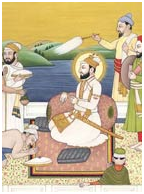 Diwali is a significant religious festival in Hinduism, Sikhism, and Jainism. It is also popularly known as the “Festival of Lights” and is a lunar-calendar based event that occurs between mid-October and mid-November. The word “Diwali” is a contraction of “Deepavali” which translates into “row of lamps”.
Diwali is a significant religious festival in Hinduism, Sikhism, and Jainism. It is also popularly known as the “Festival of Lights” and is a lunar-calendar based event that occurs between mid-October and mid-November. The word “Diwali” is a contraction of “Deepavali” which translates into “row of lamps”.
For Sikhs, Diwali is particularly important because it celebrates the release from wrongful imprisonment of the sixth guru, Guru Hargobind, and 52 other princes with him, in 1619.
Emperor Jahangir had imprisoned Guru Hargobind and 52 princes. The Emperor was asked to release Guru Hargobind which he agreed to do. However, Guru Hargobind asked that the princes be released also. The Emperor agreed, but said only those who could hold onto his cloak tail would be allowed to leave the prison. This was in order to limit the number of prisoners who could leave. With great surprise to the Emperor, the Guru had a special cloak made with 52 tassels so that all the princes could also leave the prison.
He arrived at Amritsar on Diwali day and the Harmandar Sahib was lit with hundreds of lamps to celebrate his return and hence the day came to be known as the “Bandi Chhor Divas” (“prisoner release day”).
The underlying spiritual meaning of this time of year is “the awareness of the inner light”. Central to Sikh philosophy is the assertion that there is something beyond the physical body and mind which is pure, infinite and eternal. Just as we celebrate our birthdays at the start of our physical being, Diwali represents the celebration of this inner light, in particular the knowing of which outshines all darkness; it removes all obstacles and dispels all ignorance. With this comes universal compassion, love, and the awareness of the oneness of all things (ik oankar).
This higher understanding is what was so clearly shown by the benevolent actions of Guru Hargobind which should inspire us in our own lives.
Adapted from bbc.co.uk and sikhiwiki.org
